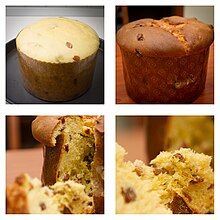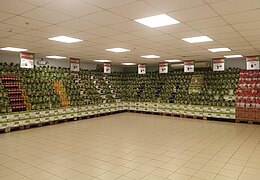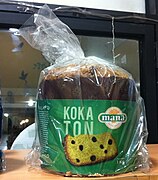Panettone
The panetone (in Italian, panettone, and this from the Milanese panetùn or panetòn, derived from pane; also called panetón in Latin America and pan dulce or pandulce in Río de la Plata) is a bun made with a brioche type dough, filled with raisins, candied fruits (orange, citron and lemon), nuts or chocolate. It is dome-shaped and the dough is made with flour, sourdough or fresh yeast, eggs, butter and sugar.
It is a traditional Christmas dessert in Milan (Italy) from where it originates and has been known since at least the year 1470; It is also very popular in South America, especially in Argentina, Brazil, Chile, Paraguay, Peru, Uruguay, and Venezuela. In Peru, in addition to being traditional at the end of the year celebrations, it is also consumed during its annual national holidays in July.
Given its international popularity, efforts are being made to obtain a geographical indication and a protected designation of origin for this product. These initiatives have become more important in recent years in view of the growing competition in various parts of the world, where panetone is very present at Christmas and New Year's parties.
Name
Sweet bread
In Argentina it has been known since the XIX century as «pan dulce», from the Italian pandolce, since immigrants from northern Italy who settled in that country brought with them the recipe for pandolce genovese ('Genoese sweet bread'), often simply called pandolce (even in northern Italy), which is shorter than the Milanese (like the German Christstollen) and usually has a higher proportion of fruit. That is to say that it was that recipe that was preserved locally and only later did the industrial forms arrive. Thus, in Argentina, Milanese sweet bread (panettone) is made industrially and is sold massively in supermarkets, while Genoese sweet bread is made artisanally by bakeries or confectioneries in the country. with traditional recipes that have been handed down from generation to generation. Its plural is "panes dulces" if it is written separately or "pandulces" if it is written all together.
Features
With its typical dome shape and a height of about 12 to 15 cm, it is filled with candied fruit. It is served in vertical slices and can be accompanied by hot chocolate or sweet wines such as asti spumante or muscatel wine, and even with wines with more body.[where?]
Panetone is consumed in different ways, either thinly or thickly sliced, for breakfast or as a dessert at the end of lunch. In some countries it is served toasted, spread with sauces, butter and jams or covered or filled with creams.
History
The ancient Romans were the first to sweeten bread with yeast and honey. His testimony is presented in a 16th-century painting by Brueghel the Elder and in a recipe book by Bartolomeo Scappi, personal cook to popes and emperors in the time of Charles V.
There are many legends about the origin of panettone. According to the first of these, the history of this dessert began more than five centuries ago, around 1490, when a young aristocrat, Ughetto Atellani de Futi, fell in love with the daughter of a Milan pastry chef. To show his love for him, he posed as a pastry chef's apprentice and invented a dome-shaped sugared bread made from candied fruits and the aroma of lemon and orange. The Milanese began to flock to the pastry shop to ask for "Toni's bread", who was the name of the helper, and from there comes the name panettone, which was adapted to "panettone" or "panetone" in Spanish.
According to another legend, probably better known, the panettone was born at the court of Ludovico el Moro, lord of Milan from 1494 to 1500, on Christmas Eve. It is said that the duke celebrated Christmas with a grand dinner, filled with delicious dishes worthy of the wealth of the Milanese court. Dessert was going to be the natural conclusion of such a luxurious banquet. However, when removing it from the oven, the cook realized that he had burned himself. There was a moment of terror in Ludovico's kitchen, but luckily a dishwasher named Antonio had thought to use the leftover ingredients to knead sweet bread and take it home. Given the situation, young Antonio proposed to the cook to serve his bread as dessert. It was a very rich sweet bread, filled with candied fruit and butter, which was immediately brought to the duke. The unusual dessert was a huge success and Ludovico asked the cook who had prepared it and what was his name. The cook introduced the duke to young Antonio, who confessed that the dessert still had no name. The lord then decided to call it “pane di Toni”, which over the centuries would become panettone.
The oldest and surest testimony of panettone is found in a record of expenses of the Almo Collegio Borromeo in Pavia in 1599: on December 23 of that year in the list of dishes planned for lunch Christmas expenses also appear for 5 pounds of butter, 2 of raisins, and 3 ounces of spices given to the baker to make 13 "loaves" to give to college students on Christmas Day.
The first record of panetone as a traditional Milanese Christmas sweet is an article by the Enlightenment writer Pietro Verri in the 18th century, who calls it pane di tono ('big bread').
Mass production
Its industrialization made its consumption traditional in Italy, and then worldwide, during Christmas. In 1919, the Milanese businessman Angelo Motta and then in 1933 Gino Alemagna launched panetone, a typical Christmas sweet, throughout Italy and the world.
In the 1950s, an Italian migrant who arrived in Brazil founded the company Bauducco, which currently produces more than 200,000 tons per year, with six factories in various countries and exporting to more than 50 of them.
Numerous variations have been derived from that first bread and can be found with grapes, raisins, candied fruits, pine nuts, almonds, chocolate and coffee. In Milan it ended up becoming a traditional Christmas dessert, especially since businessmen began to give it to their clients as gifts.
Statistics
Internationalization
Panettone is widely consumed in Christmas cuisine in Argentina, Bolivia, Brazil, Chile, Costa Rica, the United States, Paraguay, Peru, Uruguay, and Venezuela.
In Argentina
In Argentina, sweet bread (pandolce genovese or pandolce) was introduced during the 17th century XIX by immigrants from northern Italy. In its beginnings, its elaboration occurred in the family environment.
Reibaldi & Gandini, founded in 1875 by Lombard immigrants Giuseppe Reibaldi and Angelo Gandini, at 901 Corrientes street, Suipacha corner (today defunct). Records speak of numerous clients coming even from the most remote neighborhoods to acquire it, which made the confectionery built a larger building in the same place. However, at the beginning of the 1930s it was demolished due to the widening works on Corrientes street, which caused the demolition of all the fronts of the buildings erected on the sidewalk of the odd numbers, from Av. Leandro N. Alem to Av. Callao. Giuseppe Reibaldi knew that the building in which he had placed all his dreams would be destroyed and this caused him such deep sorrow that he passed away, donating his assets to the Municipal Hospital of the city. His widow, Rosa Ferrante, carried out her resolution by arranging for the construction of a Maternity Ward, which today bears the name of the donor.
Currently, Milanese-type pandulces or panettones are manufactured by various national firms in an industrial format, while the country's confectioneries continue to make the traditional pandolce with recipes handed down from generation to generation.
In Spain
In Spain its consumption is recent, taking into account that this country did not receive large waves of Italian immigrants in past centuries as it did in several American countries, panettone is perceived as foreign there. Its consumption is greater in Barcelona, the city chosen by several immigrants from Latin America. Panettone arrived in Spain for the first time at the end of the 1990s, imported in an industrial format from Italy by a supermarket chain (since Spain does not have its own panettone industry), but it was not until 2010 that it was offered in various supermarkets. It was not until 2015 that it became popular in an artisan format in some pastry shops in Barcelona.
In Peru
Peru is the largest per capita consumer of panettone in Latin America, as well as being the second largest consumer in the world with a rate of up to four panettone per family. The panettone arrived in the Andean country thanks to the Italian company Motta, although it was in the 1950s when the Peruvian company D'Onofrio, founded by immigrants from Caserta, popularized it by starting to produce it under its own brand using a slightly modified formula and packaging design from the Alemagna, with its authorization. D'Onofrio is owned by Nestlé which markets and exports its panettone to several countries in the region.
According to Radio Capital, the average Peruvian citizen consumes panetón throughout the year, especially in chocolates during the Christmas season (December) and national holidays (July). In Radio Programas del Perú, The Nestlé executive, the largest producer of panettone in the South American country, affirmed the strong presence of panettone in Peruvian culture:
In Peru, the paneton is not only food but also a gift, since five out of ten marshes are bought to be gifted to friends, family or coworkers.
Contenido relacionado
Pepperoni
Fondue
Vinegar
Sashimi bōchō
Chamomile (wine)











